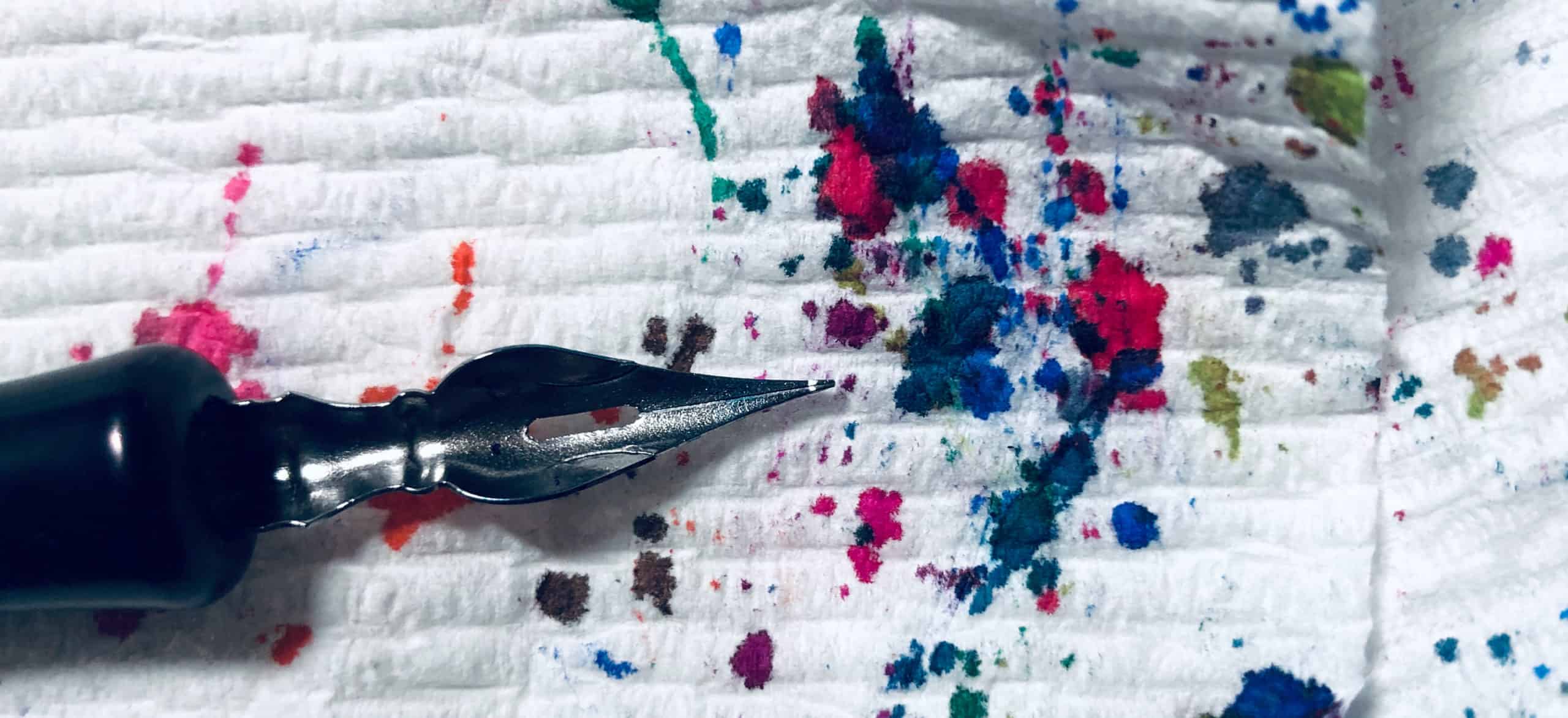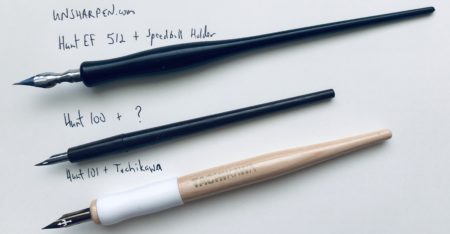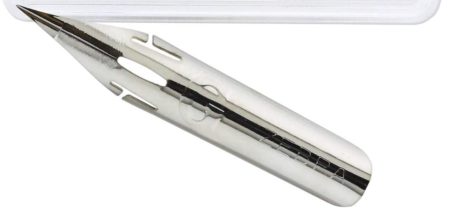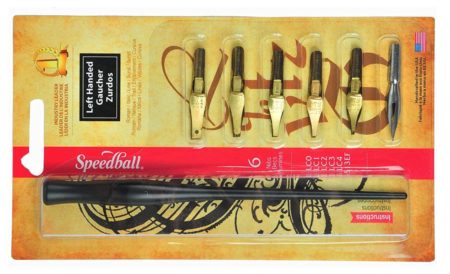It might seem obvious that a nib holder is designed to hold a nib, but what makes it a nib holder and not a fountain pen? After all, isn’t a fountain pen just a nib holding barrel with some ink and a cap?
Let’s dig into nib holders and their place in the world in 2020.
What Is and Isn’t a Nib Holder?
Modern fountain pens combine the nib, feed, section (the area you hold around the feed), cartridge, and barrel into one tidy package, but things weren’t always so well integrated. The fountain pen of yesteryear, that is to say dip-style fountain pens, were simply composed of the nib and the nib holder. Dip pens don’t have their own ink reservoir (like a cartridge or converter) and they lack feed, rather they hold on to small amounts of ink after being dipped.
So a nib holder is a piece of wood or metal that holds on to a nib. It doesn’t have any ink storage, there is no feed, there are no buttons or settings. A nib holder is a very simple tool, but there are many varieties and a few different types of these tools.
A nib holder isn’t a standard fountain pen or a feather quill. It’s not a relic from antiquity, but rather a modern tool use for artistic purposes.
Why Use a Nib Holder?
So, why would one use a nib and nib holder combination — that is to say a dip pen — when you could just get a normal fountain pen? The main thing to note is that nib holders aren’t for general writing but for specialty writing, like manga, calligraphy, and comic writing. Specialty writing means speciality nibs, and niche nibs like this are not sold built into pens!
There are dozens of kinds of loose nibs that work with a nib holder, much more than the standard Extra Fine, Fine, Medium, Broad, Oblique you might find in a fountain pen. Some varieties of speciality stand-alone nibs are:
- Hard G nibs
- Hawk quill nibs
- Spoon nibs
- Calligraphy flex nibs (Type A, B, C, etc)
- Crow quill nibs
- Maru (mapping) nibs
And that’s just a few styles! When these nibs are sold loose each one might only cost $1 to $3 and with a nib holder that costs under $20 you could have dozens of nib combinations — that is to say hundreds of pens — for not many under $100.
If you are doing real specialty writing — comic, manga, calligraphy and so on — then a nib and nib holder makes perfect sense. We also recommend using a dip pen for fountain pen ink testing as they are easy to clean and are the fastest way to test different inks one after the other.
Types of Nib Holders
When choosing a nib holder you’ll want to consider your nibs, holder material, holder shape, and holder size.
Nib Size
First off, not all nibs work with all nib holders! Nibs mount into the holder using a pressure fit in which a the semi-circular end of the nib is push into the holder. Most nibs fall into two sizes: medium or large. And these sizes roughly come down to if you are using a Japanese or Western nib. Of course there is more subtlety to this choice and many sizes but the Western vs. Japanese distinction will get you most of the way there.
If you want to get a bit more technical there is actually a third type of nib. You have:
- Small (tubular): Brause 515, Hunt 102
- Medium: Brause 511, Hunt 100
- Large: Brause 76, Nikko G, Tachikawa G, Zebra G
Common nib holders will accommodate both the medium and larger style of nibs. You’ll have to find a specialty holder to accomodate the small, tubular style (sometimes called “crow quill”).
Mount Type
Closely related to the size of the nib is the type of mount the holder uses. Almost all use a friction fit, in which the nib is pushed in between two close-fitting parts but there are variations on this. A ring holder uses concentric circles in which the end of the nib can be pushed. Other nib holders will use internal prongs — known as ferrules — that push outward and hold the nib in place. Old school nib holders will simply have slits cut into wood and the pressure of the wood will hold everything firm
All the styles work, but usually the concentric ring type is the simplest and easiest to use over time. It’s also the least prone to breaking, through if you clog up the ring area it can be very hard to clean.
Material
Nib holder material is only about what you prefer. Some are wood, some are plastic, and a few are metal, but material isn’t generally a huge deal because the holders don’t have any moving parts or flex.
Shape
Some nib holders are straight while other are curved and seemingly ergonomic. Pick what you prefer holding.
Straight or Oblique
The main choice with shape isn’t just the handle but if the you are a straight nib holder or one with an offset handle where the nib is pushed off to the side of the holder. These are known has “oblique” nib holders and they are used for calligraphy.
An oblique nib holder puts the nib out and at an angle relatively to the older. This makes writing an at angle easier, which give your calligraphy that slanted, “oblique” look that some many people are going for. If you aren’t specifically going for slanted writing, you don’t need an oblique holder and should avoid using it as it’ll make things harder than they have to be.
Size
Some writers prefer larger, more ornate nib holders and some do not. It’s more like choosing a paint brush than it is a pen, so keep that in mind because the level of control you’ll need is huge.
The Best Nib Holder
As with anything, the best nib holder will come down to your personal preference and intended uses. That said, some are better than others are worth your money.
And, keep in mind, most nib holders do not include nibs! So you’ll want to go ahead and purchase those as well.
The Best Nib Holder
The Tachikawa Comic Pen Nib Holder Model 40 (T-40) is a Japanese, comic-style nib holder that is universally loved. It sells for under $10, it looks great, and it works with a huge variety of nibs. This style of nib holder will work with super popular nibs like the Zebra Comic G, Nikko G, and so forth.
This is a wooden nib holder with a wider, ergonomic grip that comes in a handsome sky blue, white, or red grip. The rubber grommet on the inside can accommodate round and semi-circular nib mounts which will work with nibs from Zebra, Speedball, Brause, Nikko, and more.
If you want to save a few dollars you can opt for the Tachikawa Nib Holder Model 25, which drops the rubber grip and instead has a full wood handle.
Best Starter Set
While it’s not a great nib holder in and of itself, the Speedball Basic Calligraphy set remains a very good option for beginners. The single $10 set will include a nib holder and then 3 to 6 nibs, depending on the package you pick.
The nib holder that Speedball includes is comfortable and it works well, but it’s not particularly nice or fancy. The holder is plastic and totally no frills, but it’s an ideal starting point because it’s so affordable.
FAQs
Why are some nib holders so expensive and other so cheap?
The huge range in pricing is a popular question when it comes to nib holders. Entry level models from Brause, Speedball, and Tachikawa (etc.) might only cause $5 to $20 for a nib holder while small batch, artisanal nib holders from makers like Mpoblique, Tom’s Studio, and Lindsey Hook might cost over $100. In the middle you’ll fine better known pen brands like the Kaweco (with their Special Nib Holder) and Caran d’Ache.





